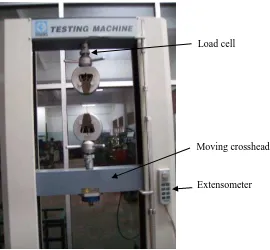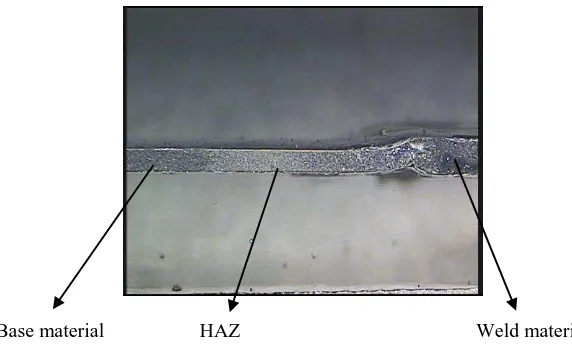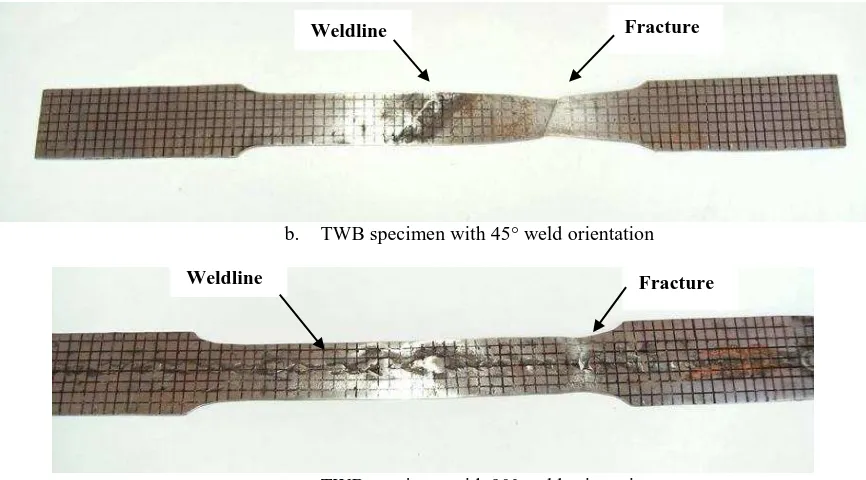A STUDY OF THE DRAWABILITY
OF TAILORED WELDED BLANKS
Tri Widodo Besar Riyadi1
Mechanical Engineering, Muhammadiyah University of Surakarta Jl. A. Yani Tromol Pos 1 Pabelan Kartasura 57102 Telp 0271 717417 ext 222
Email: tri_wbr@yahoo.com
ABSTRACT
Demand for lightweight vehicles is growing in a rapid swiftness primarily because of economical and environmental reasons. By reducing the weight of the vehicles, the fuel consumption and emissions are considerably reduced as well. For weight and cost reduction, the technology of tailor-welded blanks (TWBs) is a promising technology for both automotive and aerospace sectors. In this technology, some pieces of sheet metals are welded together prior to the forming.
Since the tailored blank is composed from different sheet metal having different sheet thickness as well as its properties, the forming of tailored blanks then creates a lot of technical problems especially in the scheme of deformation. The objective of this paper is to evaluate the drawability of Tailored Blanks.
In order to assess forming behaviour of tailor-welded blanks under the influence of weld orientation, the uniaxial tension tests have been conducted for welded specimens with the weld line oriented at different angles with respect to the direction of load. The specimens were cut from a tailor-welded blank made from the same material.
The result of experiment has shown that a weld is characterised by higher strength and lower plasticity in comparison to base material. Hence, the weld influences the strain distribution in tailor-welded specimens. This phenomenon depends strongly on the direction of the weld against the direction of tensile load. The lowest strains occur in the specimen with a longitudinal weld.
Keywords: Drawability, Tailored Blanks
Introduction
In the aerospace industry, the importance of lightweight materials has long been recognised. For automotive industrial sectors, they represent a way to beat the competition. Energy can be saved, costs can be reduced and more power can be supplied. Unfortunately, lightweight construction is often hard to achieve, because it cannot be at the expense of safety. Therefore, lightweight construction will only come to the fore if safety-optimised products and cost saving production processes can be found. The use of Tailored Blanks offers an advantageous with respect to product, process and design, since the body panels can be formed in a single stamping process.
A Tailored Blank consists of several flat sheets that are welded together before forming. A combination of different materials, thickness, and coatings can be welded together to form a blank for stamping car body panels. The main advantage of using a Tailored Blank is to have specific characteristics at particular parts of the blank in order to reduce weight and costs. Particular parts of the blank can be made from a thicker or stronger material to increase the stiffness or strength locally whilst having thinner material at other parts. Also alternative parts of the blank can be made up of coated steel to increase the resistance to corrosion whilst having bare steel at other sections. These advantages of Tailored Blanks, however, can contribute to the development of lighter car design, resulting in a reduction of the fuel consumption. This is very significant in view of the actual environment oriented age.
Theoretical Reviews
A Tailored Blank can be formed by two or more sheets that are welded together. This can be done by various welding processes, of which mash seam welding and laser welding are the commonly used processes, see Fig. 1. In 1995, Saunders et al. investigated the behaviour of Tailor Welded Blanks especially dealing with the property of different types of weld in the blank. It has been concluded that the difference of weld properties were no significant in formability. Dissimilar properties of two pieces of sheet metal in a tailor-welded blank can also cause forming problems such as decreased formability.
Fig 1 Schematic of TWB joining process for 2 different thicknesses
The material properties in the heat-affected zone adjacent to the weld and in the weld itself are significantly disadvantageous from a forming point of view compared to those of the base metal, since the material hardening in the weld and the heat-affected zone restricts the formability of a tailor-welded blank (Piela and Rojek, 2002). Some researcher have investigated and concentrated in quantifying the effects of the welding process on the formability of TWBs. Venkat et al. in 1997 has performed an investigation of Aluminum alloys 5754-O and 6111-T4 which have the combination of being both weldable and formable.
Tailored welded blanks flow in different mode due to the relationship between various thickness and strength of welded strips and the properties of the weld (Lisok, 2000; Piela et al, 2001). Thus, the same kind of uniaxial tensile tests as that carried out for homogeneous steel sheets have to be conducted to assess the drawability of tailored welded blanks. The diversified material flow of the actual tailored blank needs to be evaluated on the basis of these characteristics and numerical simulation of the drawing process (Piela et al, 2001). In general, the research dealing with the way for evaluating plastic characteristics of tailored blank will allow us to analyze the mode of flow of tailored blanks. Finally, process engineers can design the drawing process of tailored blanks more effectively, since high heterogeneity of mechanical properties and diversification of geometry are the biggest drawbacks of the process.
In the forming process of a tailor-welded blank, the deformation in the plane of the sheet steel may be represented by two components, parallel to the weld and perpendicular to the weld. The yield stress of the parallel weld is greater than the perpendicular weld, then the plastic deformation of plane perpendicular to the weld is easier. The deformation adjacent to weld originated in and is concentrated in the base material, because of the lower yield and tensile stress of the base material compared with those of the weld.
To obtain high formability it is suggested that the orientation of the weld must not be parallel to the orientation of the major stress to ensure lower plasticity of the weld than that of the base material. However, if the orientation of the weld move towards the base material, of relatively high strength or of thick gauge, because of the different work-hardening effects between the different base materials, this will cause local deformation on the side of the base material with relatively lower plasticity. Therefore, the weld design is very important in the metal forming process design of a tailor-welded blank and must be determined according to the metal flow and strain distribution during the forming process.
Experimental Set-Up
Fig. 3 Tension test specimens for 0°,90°,and 45° .
Although tensile test of TWBs is generally like other materials, some special considerations are important in testing of TWBs. The most important factor in testing of TWBs is the size of the specimens. The size of the specimens is dependent on whether the joint or the weld metal is being tested. If the joint is being tested, the specimen should include both the weld and the base metals. The results of experiment are, however, not consistent with that obtained by the standard sized specimens. This is because the contribution of the weld to the tensile load decreases as the size of the specimen increases. It can be said that the standard specimens is overestimate the ductility of the weld metal.
The formability of tailor-welded blanks is dependent on orientation of the strains with respect to the transition zone (including the weld and HAZs). The size and properties of the transition zone varies with the welding method employed. However, regardless of the welding method, the thickness difference and presence of the weld metal causes local stress and strain distribution patterns at the transition zone. For the evaluation of strain distribution on the drawn part of tailored blanks after tension test, it was decided to give some grids over the plane of the blanks.
Fig.4 Universal Testing Machine
Extensometer Moving crosshead
In order to observe the difference properties of tailored blank as a result of the weld, Vickers hardness test was performed. The geometry of the blank is divided into three zones; base material, weld material, and heat affected zones respectively. The results of the test is listed in table 1.
Base material HAZ Weld material Fig. 5 Cross section area of Hardness test specimen
Table 1. Vickers hardness test
Zones Vickers Hardness Number (VHN)
Weld 233,8
HAZ 119,9
Base material 87,76
Hardness is usually used as an indirect method to observe the ductility of the specimen. Generally, harder materials are stronger and more brittle and deform less before failure. Some studies have showed that the hardness of the welded zone of TWBs is notably changed due to welding (Zadpoor et al, 2007). Studies show that though the hardness increases in the weld zone of all steel TWBs, the level of hardness increase is dependent on the welding method and metal properties.
Results and Discussion
Taking into account to the research on the development of welding and forming technologies as conducted by Rojek (2003) and Piela (2001), it have revealed that the influence of a weld upon the process of plastic flow of the pass in the zone of joining, as occurring in the tailored blanks, can be examined by using the same kind of tests as those used for evaluating the drawability of homogeneous sheets. In fact, the tools for drawability tests applied in technological trials for uniform sheet thikness, appeared not to be suitable enough for trials on tailored blanks which are of different thickness. However, in this experiments, the thickness of steel sheets is not of particular importance. A detailed analysis has been carried out for evaluating the characteristics of welded blanks obtained in tensile tests, by taking into account different ways of joining steel sheets in a given tailored blank so that full assessment of drawability of laser-welded tailored blanks can be made. The result of tension test are shown in fig 5 as follows:
a. TWB specimen with 0° weld orientation Fracture
b. TWB specimen with 45° weld orientation
c. TWB specimen with 90° weld orientation Fig 6 Tailored Welded Blanks after tension test
Typically fractured specimens with different orientation of weld line are shown in Fig 6. Fracture always appeared in the angle of 45º which is suitable with Tresca criterion. Generally, a weld is characterized by higher strength and lower plasticity in comparison to base material. Hence, the weld influences the strain distribution in tailor-welded specimens. This phenomenon depends strongly on the direction of the weld against the direction of tensile load. The lowest strains occur in the specimen with a longitudinal weld.
It is realized that there should be a point in the mid of the plane with less thickness in order to accommodate and trigger the necking development. However in this experiment, the trigger for necking is absence so that the necking happens not in the mid of the plane. The difficulty with the weld combination is still in the consideration.
0 20 40 60 80 100 120 140 160 180
0 5 10 15 20
Strain (%)
S
tr
e
s
s
(
M
P
a
)
(a)
Weldline Fracture
0
Fig 7 True stress-strain curve for specimen with weld orientation: (a). 0°, (b). 45°, (c). 90°
An evaluation and calculation of the three specimens produced the value of strength stress, yield stress, and elongation or total strain as listed in table 2.
Table 2 Properties of TWBs
0° 45° 90° Average
UTS (MPa) 159,8 170 208 179,27
Yield Stress (MPa) 105,8 113 167.61 109,40
Total Strain 0,56 0,43 0,33 0,44
Meanwhile the properties of elastic plastic of material is assumed to follow the power law as follows:
n
T
K
K and n in the power law is determined by using the following equation: weld angle. This shows that the plastic deformation in the plane having parallel weld will be higher than in perpendicular direction. Meanwhile the property of strain hardening index is constant. This shows that the plasticity is relatively constant as well.
Strain Distribution
Strain distribution in tension test has been performed in order to observe the influence of weld toward the material flow. The calculation is begun starting from the fracture point. The result of experiment has shown that the strain distribution has a highest value near the fracture point. This means that the weld produces low plasticity. Three specimens with different angles has shown a similar trend. Comparing the three specimen, the specimen having weld angle 45º has the higher strain then other.
5 1 1 5
Fig.8 Strain Distribution of uni-axial test specimen
Conclusion
With respect to the tension test of tailored blank experiments, it was found that the presence of the weld has significantly influenced the properties of tailored blanks. Orientation of weld angle in the plane has affect the forming behaviour of the material. The strength of the parallel weld is greater than the perpendicular weld, then the plastic deformation of plane perpendicular to the weld is easier. The material flow is also significantly affected by the weld.
References
Saunders F.I, Wagoner R.H., The use of tailor-welded blanks in automotive applications, in: S.-F. Shen, P.R. Dawson (Eds.), Simulation of Materials Processing: Theory, Methods and Applications, 1995, Balkema, Rotterdam, pp. 157-163.
Piela A, J. Rojek, Experimental study and modelling of tailor welded blanks, in: Proceedings of the Numisheet, 2002, pp. 225–230.
Venkat, B. S., Albright, C. E., Ramasamy, S., and Hurley, J. P., (1997), “CO2 Laser Beam Welding of Aluminum 5754-O and 6111-T4 Alloys”, Welding Journal, Vol. 76, No. 7, July, pp. 275-82s. Lisok J.: Tailored Blanks, Conf. Proc. Junior-Euromat 2000, Switzerland, Lousanne, 28.08.2000–01.09.2000,
334.
Piela A., Kocañda A., Zimniak Z.: FEM simulation of drawing of tailored blanks, Numiform 2001, The 7th International Conference on Numerical Methods in Industrial Forming Processes, 18–21.06.2001, Toyohashi, Japan, 795–800.
Rojek J., Piela A., Lisok J.: Numerical simulation of tailor welded blanks, The 15th International Conference
on Computer Methods in Mechanics CMM-2003, Gliwice- Wis³a, 3–6.06.2003, 305.
Piela A., Lisok J., Rojek J.: Experimental study and numerical simulation of tailor welded blanks, International Conference on Advanced Materials & Processing Technologies AMPT 2003, 8-11.07.2003, Dublin City University, Ireland.
Zadpoor, J. Sinke and R. Benedictus, Mechanics of Tailor Welded Blanks: An Overview, Key Engineering Materials Vol. 344 (2007) pp. 373-382





